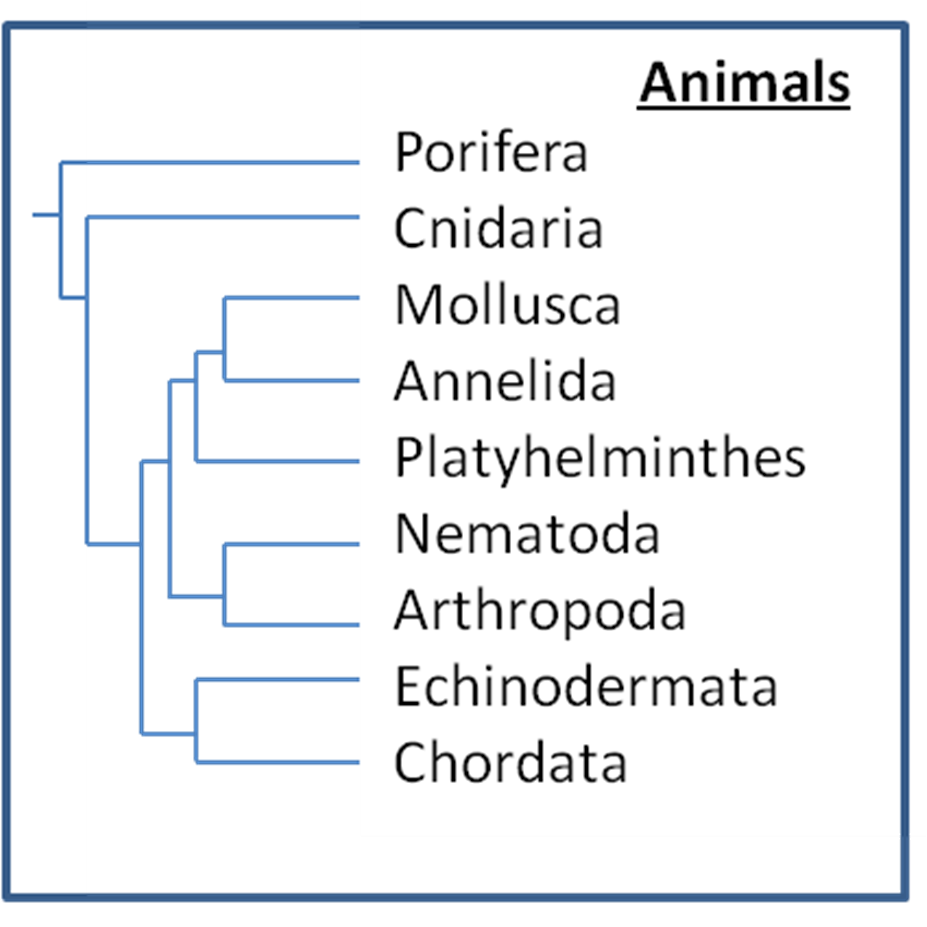Classification
Domain: Eukarya
Organisms in Eukarya contain nucleated cells with membrane-bound
organelles.
Kingdom: Animalia
All organisms in Animalia are multicellular, lack cell walls, and
are heterotrophic (meaning they acquire nutrients through consuming
other organisms).
Phyla: Chordata
Organisms in Chordata are primarily identified by the presence of a
notochord, which is a rod-like, skeletal structure that is present
in early embryonic stages of development. Additionally, they have a
nerve cord (a hollow tube above notochord) and visceral clefts and
arches (located by the pharynx). (Encyclopedia of Life 2014)
The above figure shows where the phylum Chordata fits in the kingdom Animailia. Chordata is most closely related to Echinodermata.
Class: Osteichthyes
Also referred to as the bony fishes, this class is distinct because
it has a skeleton reinforced by calcium salts and is much stiffer
than the skeleton of cartilaginous fish. Another adaptation in this
class includes an organ called a swim bladder that allows the fish
to float in the water. Also, they have an operculum that allows them
to breathe without swimming. Other special adaptations include many
teeth, paired fins, and numerous vertebrae. (Fernbank Science
Center)
Order: Pleuronectiformes
Commonly referred to as flatfishes, organisms in Pleuronectiformes
are asymmetrical and have highly compressed bodies. Larval organisms
have an eye on each side of their head, but eventually one eye
migrates to the other side, leading adults to have both eyes on the
same side of their head. (Encyclopedia Britannica 2014)
Family: Bothidae
Organisms in Bothidae have their eyes on the left side of their
body. The pelvic fin base is long on the ocular side and short on
the blind side. Additionally, gill membranes are connected, the anus
is generally far up on the blind side, and anal fin rays are
shortened posteriorly. (Encyclopedia Britannica 2014)
The above figure shows the relationship of the family Bothidae to
three other families within the order Pleuronectiformes. The
families Scophtahlmidae, Bothidae, and Paralichthyidae all have
left-eyed flounders, while Pleuronectidae contains right-eyed
flounders (ArcanthoWeb 2014).
Genus: Bothus
Organisms in Bothus have a very flat and deep body. Additionally,
the membrane joining the operculum to the pectoral fin is scaleless.
A lateral line is only developed on the eyed side. (Marine Species
Identification Portal 2014)
Species: Bothus lunatus
Bothus lunatus is distinguished by it ability to camouflage to
the bottom substrate. Additionally, the fins and head contain many
blue spots. (Marine Species Identification Portal 2014) If you would like to learn more about
this species, feel free to explore this website.
If you would like to continue and learn about the habitat and
geography of B. lunatus, click
here
If you would like to go back to the home page, click
here

